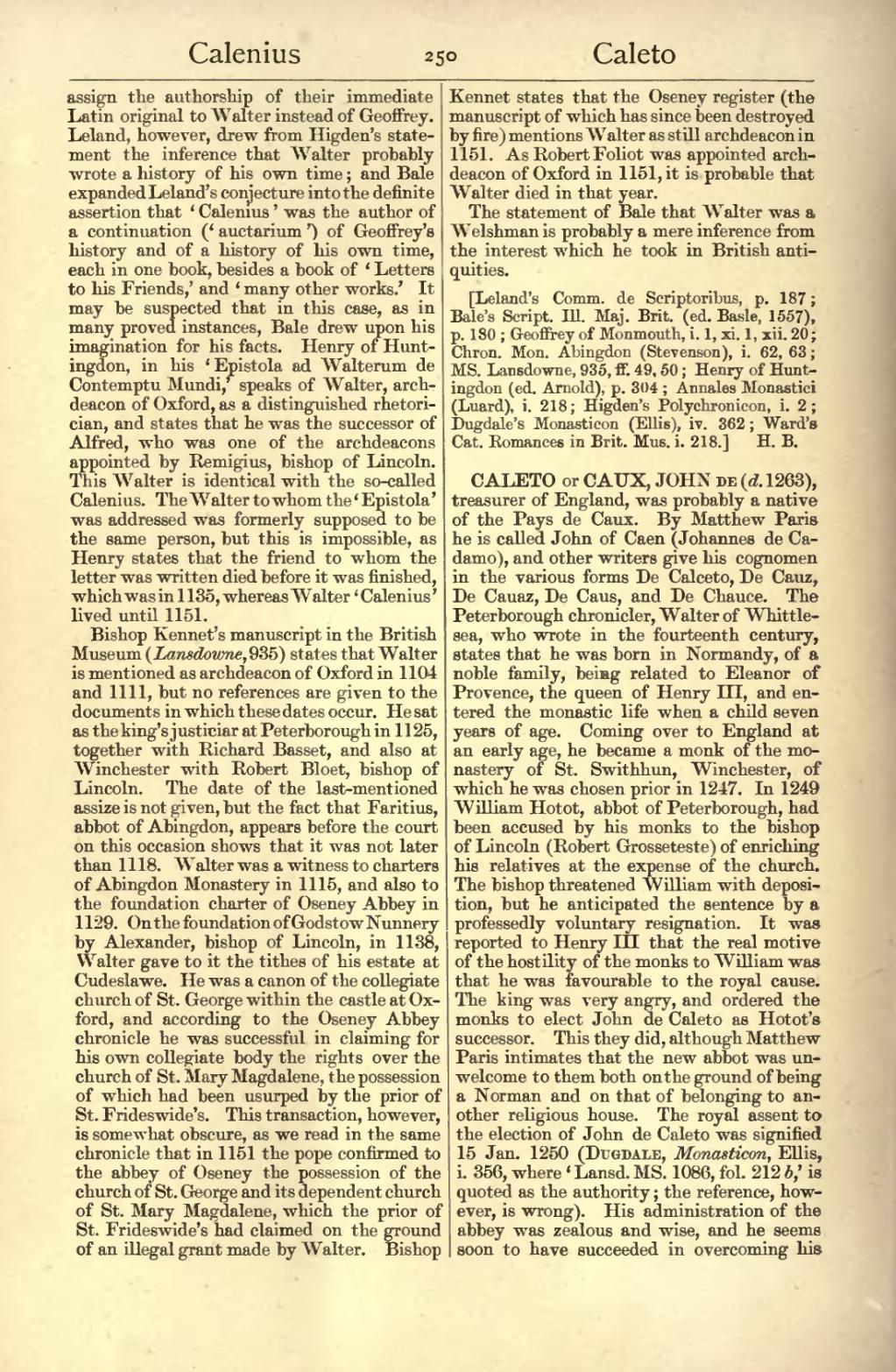assign the authorship of their immediate Latin original to Walter instead of Geoffrey. Leland, however, drew from Higden's statement the inference that Walter probably wrote a history of his own time; and Bale expanded Leland's conjecture into the definite assertion that ‘Calenius’ was the author of a continuation (‘auctarium’) of Geoffrey's history and of a history of his own time, each in one book, besides a book of ‘Letters to his Friends,’ and ‘many other works.’ It may be suspected that in this case, as in many proved instances, Bale drew upon his imagination for his facts. Henry of Huntingdon, in his ‘Epistola ad Walterum de Contemptu Mundi,’ speaks of Walter, archdeacon of Oxford, as a distinguished rhetorician, and states that he was the successor of Alfred, who was one of the archdeacons appointed by Remigius, bishop of Lincoln. This Walter is identical with the so-called Calenius. The Walter to whom the ‘Epistola’ was addressed was formerly supposed to be the same person, but this is impossible, as Henry states that the friend to whom the letter was written died before it was finished, which was in 1135, whereas Walter ‘Calenius’ lived until 1151.
Bishop Kennet's manuscript in the British Museum (Lansdowne, 935) states that Walter is mentioned as archdeacon of Oxford in 1104 and 1111, but no references are given to the documents in which these dates occur. He sat as the king's justiciar at Peterborough in 1125, together with Richard Basset, and also at Winchester with Robert Bloet, bishop of Lincoln. The date of the last-mentioned assize is not given, but the fact that Faritius, abbot of Abingdon, appears before the court on this occasion shows that it was not later than 1118. Walter was a witness to charters of Abingdon Monastery in 1115, and also to the foundation charter of Oseney Abbey in 1129. On the foundation of Godstow Nunnery by Alexander, bishop of Lincoln, in 1138, Walter gave to it the tithes of his estate at Cudeslawe. He was a canon of the collegiate church of St. George within the castle at Oxford, and according to the Oseney Abbey chronicle he was successful in claiming for his own collegiate body the rights over the church of St. Mary Magdalene, the possession of which had been usurped by the prior of St. Frideswide's. This transaction, however, is somewhat obscure, as we read in the same chronicle that in 1151 the pope confirmed to the abbey of Oseney the possession of the church of St. George and its dependent church of St. Mary Magdalene, which the prior of St. Frideswide's had claimed on the ground of an illegal grant made by Walter. Bishop Kennet states that the Oseney register (the manuscript of which has since been destroyed by fire) mentions Walter as still archdeacon in 1151. As Robert Foliot was appointed archdeacon of Oxford in 1151, it is probable that Walter died in that year.
The statement of Bale that Walter was a Welshman is probably a mere inference from the interest which he took in British antiquities.
[Leland's Comm. de Scriptoribus, p. 187; Bale's Script. Ill. Maj. Brit. (ed. Basle, 1557), p. 180; Geoffrey of Monmouth, i. 1, xi. 1, xii. 20; Chron. Mon. Abingdon (Stevenson), i. 62, 63; MS. Lansdowne, 935, ff. 49, 50; Henry of Huntingdon (ed. Arnold), p. 304; Annales Monastici (Luard), i. 218; Higden's Polychronicon, i. 2; Dugdale's Monasticon (Ellis), iv. 362; Ward's Cat. Romances in Brit. Mus. i. 218.]
CALETO or CAUX, JOHN de (d. 1263), treasurer of England, was probably a native of the Pays de Caux. By Matthew Paris he is called John of Caen (Johannes de Cadamo), and other writers give his cognomen in the various forms De Calceto, De Cauz, De Cauaz, De Caus, and De Chauce. The Peterborough chronicler, Walter of Whittlesea, who wrote in the fourteenth century, states that he was born in Normandy, of a noble family, being related to Eleanor of Provence, the queen of Henry III, and entered the monastic life when a child seven years of age. Coming over to England at an early age, he became a monk of the monastery of St. Swithhun, Winchester, of which he was chosen prior in 1247. In 1249 William Hotot, abbot of Peterborough, had been accused by his monks to the bishop of Lincoln (Robert Grosseteste) of enriching his relatives at the expense of the church. The bishop threatened William with deposition, but he anticipated the sentence by a professedly voluntary resignation. It was reported to Henry III that the real motive of the hostility of the monks to William was that he was favourable to the royal cause. The king was very angry, and ordered the monks to elect John de Caleto as Hotot's successor. This they did, although Matthew Paris intimates that the new abbot was unwelcome to them both on the ground of being a Norman and on that of belonging to another religious house. The royal assent to the election of John de Caleto was signified 15 Jan. 1250 (Dugdale, Monasticon, Ellis, i. 356, where ‘Lansd. MS. 1086, fol. 212 b,’ is quoted as the authority; the reference, however, is wrong). His administration of the abbey was zealous and wise, and he seems soon to have succeeded in overcoming his
